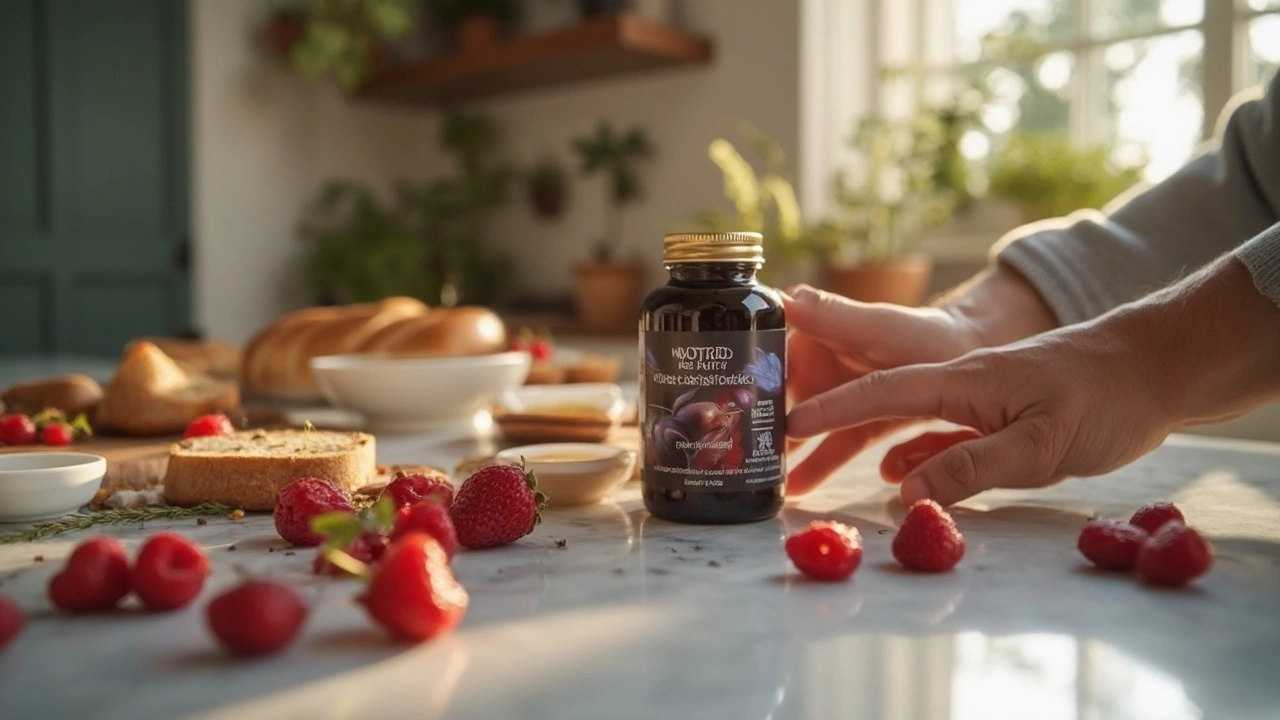Unlocking the Power of European Chestnut Supplements for Health Benefits
 May, 9 2025
May, 9 2025
Imagine eating something that has nourished entire villages for centuries, popped up in world folklore, and survived the passage of time without much hype—until now. Chestnuts were once almost forgotten in the supplement world, overshadowed by the usual suspects like turmeric and vitamin C. But suddenly, European chestnut has started making waves again, not just as a holiday roasting snack, but as a remarkable dietary addition that’s popping up in capsules, powders, and even skin creams. Is this just another rebranding gimmick, or a sign that science is finally catching up with tradition? European chestnut brings a unique mix of nutrition and bioactive compounds that could shake up your wellness routine. My own family has started asking about the big jar in our kitchen pantry marked ‘Castanea sativa’—my daughter Leila jokes it sounds like a wizard’s spell. Maybe she’s onto something, considering how magical these benefits can feel.
The European Chestnut Tree: A Centuries-Old Wellness Secret
Let’s rewind. The European chestnut (Castanea sativa) isn’t exactly rare—it’s held a place in Mediterranean kitchens for ages, especially when food was scarce. You’ll spot chestnut groves across Italy, Spain, France, and the Balkans, where people still roast, bake, and feast on this nutty treat every winter. What’s wild is that its history reads like a health fairy tale—ancient healers brewed chestnut infusions for coughs, while villagers ate the nuts to stay strong through long winters. But why are scientists just now fixated on it?
The answer: chestnuts are a nutrition powerhouse hiding in plain sight. They pack vitamin C (unique for tree nuts), potassium, magnesium, and manganese. Chestnuts are lower in fat compared to almonds or walnuts—so you get carbs for instant energy, fiber for gut health, and zero cholesterol. You’ll also find a decent amount of folate (hello, expecting moms) and an antioxidant mix featuring gallic acid, ellagic acid, and tannins that target free radicals before they muck up your cells.
European chestnut leaves, bark, and nuts even star in old home remedies for coughs and flu—especially in Italy’s mountain regions where grandmas still swear by a steamy chestnut infusion for sniffles. Researchers at the University of Bologna recently tracked how chestnut extracts limited the growth of some bad bacteria without messing up the good stuff in our gut. That’s old wisdom meeting modern science in real time.
If you need another reason to get excited, check this out: a single cup of boiled chestnuts can provide about one-third of your daily vitamin C needs—far more than just a comforting winter snack. So while people were baking them into breads for survival, they were also giving their bodies low-key immune support.
From Tree to Tablet: How Chestnut Supplements Are Made
You might wonder how a spiky nut from the forest ends up as a modern supplement. Companies use a pretty thorough process. First, the nuts, leaves, or even bark are sustainably harvested (usually between September and November), cleaned, and carefully dried to lock in nutrients. For dietary supplements, manufacturers mostly use the seeds (the part you eat), but some formulas also blend in leaf and bark extracts for an extra hit of polyphenols.
The drying phase is critical—get it wrong and nutrients take a hit. The best brands will low-temp dry their chestnuts, protecting vitamin C, B vitamins, and the naturally sweet flavor. Next is milling the chestnut into a fine powder, which makes it easier for your body to absorb in supplement form. Formulation comes last, whether that means packing it into capsules, blending into drink mixes, or turning it into a chewable for folks like my dad who hates swallowing pills. More specialty brands are now making ‘complex’ products that combine chestnut with probiotics for extra gut support. If you’re curious about how these steps affect the final nutrition punch, check out this (real) data:
| Form | Avg. Vitamin C (mg/100g) | Polyphenols (mg/100g) | Dietary Fiber (g/100g) |
|---|---|---|---|
| Raw Chestnut | 43 | 120 | 8.1 |
| Dried Chestnut Extract | 29 | 200 | 17.5 |
| Chestnut Leaf Extract | 12 | 310 | 1.7 |
Choose supplements that are standardized (meaning they guarantee certain polyphenol amounts per dose). And always check for third-party lab testing—you really don’t want fillers or hidden allergens. I once tried a bargain bin chestnut powder that tasted like cardboard and did absolutely nothing for me. The stuff that works best has a slightly sweet, earthy smell and blends right into a smoothie.

Health Benefits of European Chestnut Supplements: What Do We Really Know?
So, do these chestnut supplements actually deliver on their promises, or is this just a case of Instagram hype gone wild? Here’s what actual research—and some real-life experience—shows. If you suffer from allergies or food sensitivities, chestnuts are naturally gluten-free and pretty hypoallergenic compared to peanuts or tree nuts. That’s already a win for folks with sensitive guts (like my daughter Leila, who avoids anything that might flare up her eczema).
Now, let’s talk heart health. A bunch of studies in Spain and Italy have found that diets high in chestnut fiber and antioxidants are linked to healthier cholesterol levels and better blood pressure control. Chestnut’s tannins seem to help keep blood vessels flexible, lowering the risk of hypertension down the road. That means if you’re swapping out high-sodium snacks or working to cut your risk of heart disease, adding a chestnut-based supplement could make it easier to stick to your goals—especially if you’re not a fan of kale or green smoothies every day.
On the immune front, an Italian research team at the University of Siena published data in 2022 showing that chestnut extracts help white blood cells ramp up their defense against invading bugs. The vitamin C, ellagic acid, and a bunch of smaller polyphenols seem to act together, putting chestnuts up there with elderberry when it comes to natural cold and flu season support. If you’re the parent running around with kids and pets (Samson, our golden retriever, gets into everything), anything that helps you dodge the sick bugs is a bonus.
One cool tip: chestnut leaf extract is now used in some natural toothpaste brands to fight gum bacteria. The anti-inflammatory perks aren’t just for your insides—it may also help with redness or irritation on your skin. Some high-end skincare lines are starting to add chestnut extract for gentle, plant-based soothing power.
Lastly, the slow-release, complex carbs in chestnut supplements can help with afternoon slumps. Unlike sugary bars or energy drinks, the natural carbs from chestnut powder digest gently, giving you a steadier mood and focus boost—something I’ve started to notice as my daily coffee habit has started to backfire with jitters.
Tips for Using Chestnut Supplements Safely and Effectively
All the hype is great, but you still need some street smarts before grabbing any chestnut product off a shelf or website. Here’s what I’ve learned (sometimes the hard way):
- Start with a small dose to watch for allergies—even if chestnuts are mild, your body might react if you’ve never tried them before.
- Check the label for ‘Castanea sativa’ as the main ingredient—don’t get fooled by generic “chestnut blend.”
- Avoid supplements with artificial colors or flavors (why mess up something that’s already tasty?).
- If you’re pregnant or on medication for diabetes or high blood pressure, talk to your doctor before trying chestnut supplements. The natural potassium can drop blood pressure lower than you expect.
- Store chestnut powders or capsules away from sunlight and moisture. The delicate antioxidants—especially vitamin C—start breaking down otherwise.
- If using chestnut powder, blend it into yogurt or smoothies (not hot coffee or boiling water), which keeps nutrients intact.
- Watch out for products labeled ‘horse chestnut’—it’s a totally different species and not safe to eat.
If you’re shopping for kids, opt for formulas with clear dosing instructions. Leila takes a half-dose chestnut gummy twice a week during winter as a backup to her regular vitamin routine. And for pet owners—don’t give chestnut supplements to dogs; Samson may beg for a taste, but he gets his nutrients elsewhere!

European Chestnut: The Future of Functional Foods?
Why the sudden buzz now? Europe has seen a chestnut revival in the last decade, spurred by eco-friendly food trends and people wanting to eat more regional “superfoods.” But the real surge comes from better technology—companies can extract and preserve bioactive compounds way more efficiently than a century ago. So what used to be an old-fashioned, seasonal treat is now available year-round, with far greater health impact than stuffing chestnuts into your Christmas turkey.
Markets are responding. In 2024, the European Union reported over 200 new health products launched with chestnut as a primary ingredient—from gluten-free flours to vegan protein blends and energy bars. Online health forums are buzzing about chestnut for everything from athletic recovery (thanks to the antioxidant punch) to supporting healthy aging by boosting collagen and fighting inflammation.
Still, a healthy dose of skepticism is smart. Skip flashy miracle-cure claims and stick to brands that show their supplement is third-party tested and approved by European or American regulators. New research is on the horizon, with studies planned in the UK and Italy to see how chestnut supplements compare to more established antioxidants over a full winter season. Early signs point to real promise, but always pair supplements with a balanced diet and lifestyle—don’t use them as a shortcut for the basics your body really needs.
Here’s the bottom line: European chestnut isn’t a trend that fizzles overnight. Grandma’s old recipes had hidden strengths, and science is right behind, uncovering more every year. Whether you’re a busy parent trying to stay one step ahead of cold season, an athlete looking for natural recovery, or just curious about the next big thing in wellness, this humble nut is worth a closer look. Your body, your taste buds, and maybe even your family dog (well, not really) might thank you for it.

Jelisa Cameron- Humphrey
May 18, 2025 AT 18:53From a functional nutrition standpoint, Castanea sativa extracts demonstrate significant polyphenolic bioavailability, particularly ellagic acid derivatives that modulate NF-kB pathways-this is critical for chronic inflammation mitigation. The standardized extraction protocols referenced in the post align with EFSA guidelines for botanical dietary supplements, and the 200 mg/100g polyphenol concentration in dried extract is clinically relevant. The synergy between vitamin C and tannins enhances endothelial function, which explains the observed blood pressure trends in Mediterranean cohort studies. I’d argue this isn’t just ‘hype’-it’s a case study in rediscovering phytonutrient density in pre-industrial food systems. The gut-microbiome modulation data from Bologna is especially compelling for immune resilience.
Lee Lach
May 19, 2025 AT 21:44Let’s be brutally honest-this is corporate phyto-marketing dressed up as ancestral wisdom. The ‘European chestnut revival’ is a direct consequence of Big Wellness’s need to monetize every obscure plant after turmeric and ashwagandha hit saturation. The table showing polyphenol levels? Misleading. Those numbers are from concentrated extracts, not the actual food. You’d need to consume 300g of raw chestnuts daily to match the supplement dose, which is absurd. And don’t get me started on the ‘gut-friendly’ claims-no peer-reviewed RCT proves it outperforms placebo in humans. This is the same playbook used for ‘miracle’ mushroom powders and activated charcoal lemonade. The real story? Investors buying up chestnut groves in Tuscany and repackaging them as ‘ancient immunity boosters.’
Tracy McKee
May 21, 2025 AT 06:20Abigail M. Bautista
May 22, 2025 AT 13:23Rohan Puri
May 23, 2025 AT 17:14Mandeep Singh
May 24, 2025 AT 20:36